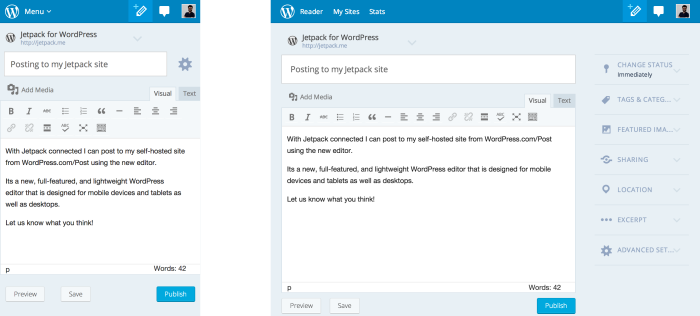Jetpack 3.2 was released last week, featuring a new site logo feature for theme authors, bug fixes, and performance improvements. Today the Jetpack team officially announced the release, along with a new feature that wasn’t mentioned in the changelog.
Centralized Posting from WordPress.com
Self-hosted WordPress sites connected via Jetpack can now publish posts using the WordPress.com post editor. When you visit wordpress.com/post/ you’ll find a dropdown of your sites above the title field. Here you can select a Jetpack-connected site. Once you either save or publish a post, a progress bar crawls across the screen as WordPress.com communicates to your site.
On first look, it seems that WordPress.com is aiming to become a centralized place for publishing WordPress content, regardless of where the site is hosted.
But this begs the question: Why would I want to post to my self-hosted site from WordPress.com? Many themes now incorporate customized editor styles to help match the preview to the frontend a little better. The self-hosted post editor also includes better access to the rest of your content and integration with plugins you’ve added to customize that experience.
The Idea Behind Centralizing Posting from WordPress.com
I spoke with Jetpack team member George Stephanis regarding the idea and direction behind the new centralized publishing option. He identified a number of complementary purposes for the new feature. “One is to dogfood the WordPress.com REST API,” he said. “By using the REST API instead of the traditional wp-admin means, we can ensure we’ve covered edge cases in usage and that it’s appropriate for production usage.”
He also sees the new posting option as a convenient way to get quick access to any of your sites. “Another purpose is for users that have fifty sites, and just want to throw quick thoughts up,” Stephanis said. When you have that many sites, accessing one through WordPress.com can be easier than going to the self-hosted admin and authenticating.
However, he recognizes that centralized publishing is not necessarily beneficial for every site. “In-depth posts to customized installs will naturally have a better experience going right to their customized wp-admin editor.”
After testing, I can confirm that it is fully functional for remote publishing, although it leaves somewhat of a disconnect between writing and seeing the live content. If you publish content, chances are that you want to visit your site anyway to see it live. Unless you’re simply saving a quick draft to your site, remote publishing doesn’t yet appear to have many advantages apart from convenience.
Experimenting with the WordPress Admin
The centralized publishing experience is just a first step, Stephanis said. The Jetpack team has more planned. “There’s more iterations and ways of managing and writing content that we can slip in more comfortably to the new WordPress.com editor, specifically as it doesn’t have to support a lot of the old metaboxes and custom stuff that wp-admin has,” he explained. “So it’s a way to safely iterate, while still maintaining the old wp-admin side.”
The upcoming WP REST API for WordPress core, along with ongoing experiments with the Press This feature, will open up many more opportunities for developers to publish to WordPress without using the traditional admin at all. The folks at WordPress.com are experimenting with their own REST API and Stephanis said he is “eager to see the external APIs converge, as there’s a lot that both current implementations can gain from the other.”
Centralized publishing isn’t the first WordPress.com REST API experiment. The Postbot app introduced users to the possibility of publishing images without the admin. The WordPress.com API team also created Sulfer, an open source media manager app built in JavaScript, using the API.
How long before the “old” WordPress admin is obsolete? “The old wp-admin is never going away, from WordPress.com or self-hosted,” Stephanis said. “But in the world of API driven development, this is a big step forward.
“By ensuring that our WordPress.com Editor can post comfortably to self-hosted sites and WordPress.com sites, that also ensures that third party clients can operate more confidently and that some of the odd quirks and edge cases have been ironed out already.”
If you want to see the WordPress.com REST API in action, simply log into your account and post to one of your Jetpack-connected sites. Do you think you’ll use this feature often? Given that it’s only the first version, how do you think it could be improved to better support self-hosted publishers?

If you can combine centralized posting, as a first step in something more, with the Google Apps for Work integration, does that move WordPress.com closer to being a digital office of sorts or, at least, a homebase?
Google Apps for Work integration:
http://en.blog.wordpress.com/2014/10/13/google-apps-integration/